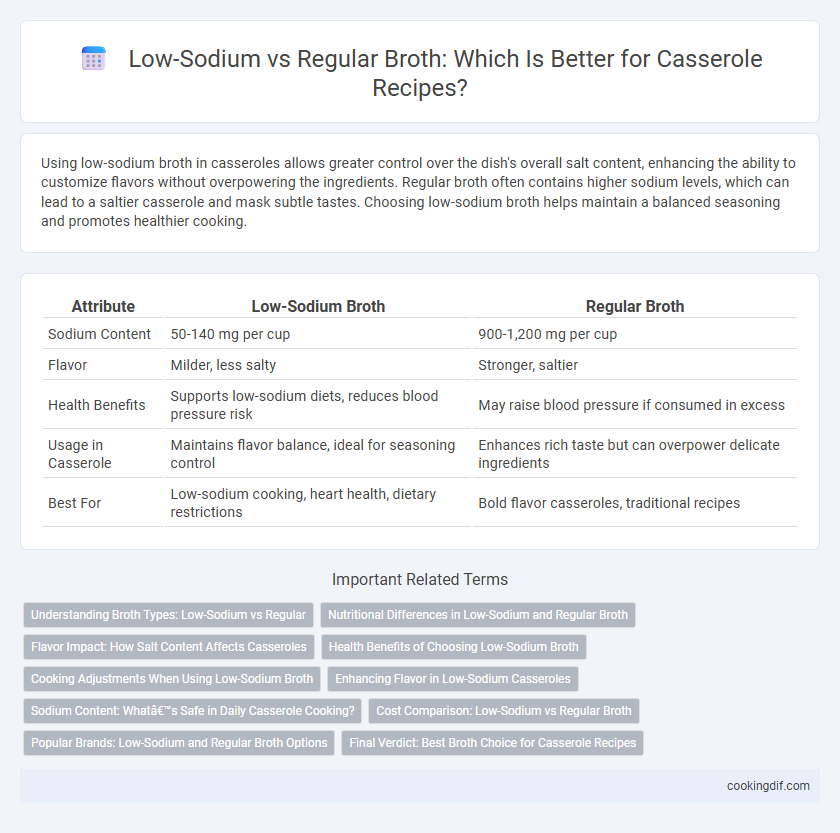Using low-sodium broth in casseroles allows greater control over the dish's overall salt content, enhancing the ability to customize flavors without overpowering the ingredients. Regular broth often contains higher sodium levels, which can lead to a saltier casserole and mask subtle tastes. Choosing low-sodium broth helps maintain a balanced seasoning and promotes healthier cooking.
Table of Comparison
| Attribute | Low-Sodium Broth | Regular Broth |
|---|---|---|
| Sodium Content | 50-140 mg per cup | 900-1,200 mg per cup |
| Flavor | Milder, less salty | Stronger, saltier |
| Health Benefits | Supports low-sodium diets, reduces blood pressure risk | May raise blood pressure if consumed in excess |
| Usage in Casserole | Maintains flavor balance, ideal for seasoning control | Enhances rich taste but can overpower delicate ingredients |
| Best For | Low-sodium cooking, heart health, dietary restrictions | Bold flavor casseroles, traditional recipes |
Understanding Broth Types: Low-Sodium vs Regular
Low-sodium broth contains significantly less salt than regular broth, making it a healthier option for casseroles aimed at reducing sodium intake. Regular broth offers a richer, more robust flavor that can enhance the overall taste but may contribute to higher sodium levels. Choosing between low-sodium and regular broth depends on dietary needs and flavor preferences, with low-sodium broth allowing for more controlled seasoning adjustments.
Nutritional Differences in Low-Sodium and Regular Broth
Low-sodium broth contains significantly reduced sodium levels, typically around 140 mg per serving, compared to regular broth, which can have 700 mg or more, making it a heart-healthy choice for reducing blood pressure and cardiovascular risk. Both types provide similar amounts of essential minerals and vitamins like potassium and magnesium, but low-sodium options help manage daily sodium intake without sacrificing flavor depth in casseroles. Opting for low-sodium broth supports dietary guidelines recommending less than 2,300 mg of sodium per day while maintaining the savory liquid base essential for tender, flavorful casserole dishes.
Flavor Impact: How Salt Content Affects Casseroles
Low-sodium broth preserves the natural flavors of vegetables and herbs in casseroles, allowing individual ingredients to shine without being overwhelmed by saltiness. Regular broth, with higher salt content, enhances savory depth but can mask subtle spices and potentially lead to an overly salty dish. Choosing low-sodium broth provides greater control over seasoning balance, crucial for achieving a well-rounded flavor profile in casserole recipes.
Health Benefits of Choosing Low-Sodium Broth
Low-sodium broth significantly reduces sodium intake, supporting better heart health and lowering the risk of hypertension compared to regular broth. Using low-sodium broth in casseroles helps control blood pressure without sacrificing flavor, making it ideal for individuals managing cardiovascular conditions. This healthier liquid choice enhances overall wellness by promoting sodium balance and reducing water retention.
Cooking Adjustments When Using Low-Sodium Broth
Using low-sodium broth in casseroles allows for better control over overall salt levels, essential for a heart-healthy diet. Adjust seasoning gradually by adding salt in small increments during cooking to avoid under or over-salting. Monitor taste and moisture, as low-sodium broth may require slight increases in herbs or spices to enhance flavor without adding extra sodium.
Enhancing Flavor in Low-Sodium Casseroles
Low-sodium broth preserves the natural flavors of ingredients in casseroles without overwhelming the dish with salt, allowing spices and herbs to shine. Using low-sodium broth enables precise control over overall seasoning, which enhances the depth and complexity of the casserole's flavor profile. This approach benefits those monitoring sodium intake while maintaining rich, balanced taste in each serving.
Sodium Content: What’s Safe in Daily Casserole Cooking?
Low-sodium broth contains typically 140 mg or less of sodium per serving, making it a safer choice for daily casserole cooking to manage sodium intake and reduce the risk of hypertension. Regular broth often contains 700 mg or more of sodium per serving, which can quickly exceed recommended daily limits when used in multiple servings of casseroles. Using low-sodium broth allows greater control over overall sodium content, supporting heart health without compromising flavor in casseroles.
Cost Comparison: Low-Sodium vs Regular Broth
Low-sodium broth typically costs slightly more than regular broth due to the additional processing required to reduce sodium content. Regular broth is often more affordable, making it a cost-effective option for casserole recipes where sodium control is less critical. Comparing prices per ounce reveals that the price gap can influence budget-conscious cooks to choose regular broth despite the health benefits of low-sodium alternatives.
Popular Brands: Low-Sodium and Regular Broth Options
Popular brands like Swanson, Pacific Foods, and College Inn offer both low-sodium and regular broth options, catering to different dietary needs in casseroles. Low-sodium broths contain approximately 140 mg of sodium per serving, significantly less than regular versions which can exceed 700 mg per serving. Choosing low-sodium broth helps control sodium intake without compromising the rich flavor essential for a savory casserole.
Final Verdict: Best Broth Choice for Casserole Recipes
Low-sodium broth is the best choice for casserole recipes as it allows greater control over the dish's overall salt content and enhances the natural flavors of ingredients without overpowering them. Regular broth, often high in sodium, can lead to an overly salty final dish and diminish the complexity of other seasonings. Using low-sodium broth ensures a balanced, flavorful casserole while supporting healthier dietary preferences.
Low-sodium vs Regular broth for liquid Infographic

 cookingdif.com
cookingdif.com